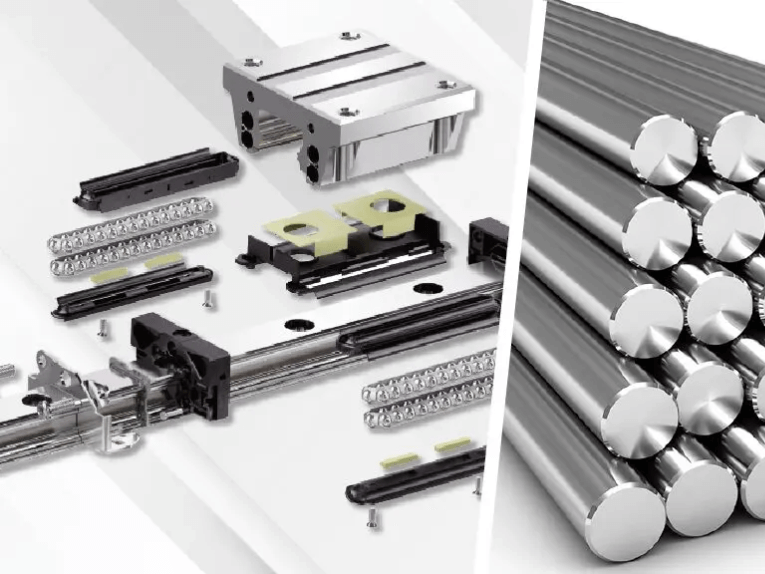What are Linear Rods?
Linear rods, often referred to as linear bearing shafts, serve as the backbone of countless linear motion systems across various industries. These essential components work harmoniously with linear bearings or bushings to facilitate smooth and precise movement in a wide range of applications.
Crafted with meticulous attention to detail, linear rods undergo rigorous manufacturing processes to ensure durability, accuracy, and reliability. Typically made from materials such as CF53 Steel, CF53 Chrome Plated Steel, and X46 stainless steel, these rods are engineered to withstand the demanding conditions of industrial environments.
One of the defining features of linear rods is their versatility in diameter sizes, ranging from 5mm to 60mm. This extensive range allows engineers to select the appropriate diameter based on the specific load requirements and spatial constraints of their application.
The manufacturing process of linear rods involves induction hardening and precision grinding. Induction hardening imparts strength and resilience to the rods, enhancing their ability to withstand heavy loads and resist wear over time. Precision grinding ensures that the surface of the rods is smooth and uniform, minimizing friction and ensuring consistent performance.
Their versatility, durability, and reliability make them an indispensable component in various industries, from manufacturing and automation to aerospace and medical technology.
Advantages of Linear Rods
When looking at linear rails vs linear rods, linear rods offer several advantages, making them a compelling choice for many applications:
- Cost-Effectiveness: Linear rods provide a cost-effective solution for linear motion applications, making them an attractive option for projects with budget constraints.
- Precision: Despite their cost-effective nature, linear rods offer a good level of precision, ensuring accurate movement in industrial applications.
- Ease of Installation and Maintenance: These rods boast straightforward installation procedures and minimal maintenance requirements, saving time and effort during assembly and upkeep.
- Compatibility: Linear rods are compatible with a wide range of linear bearings, offering flexibility and versatility in system design.
- Resistance to Wear and Corrosion: Thanks to their robust construction and materials, linear rods exhibit resistance to wear and corrosion, ensuring longevity and reliability in harsh environments.
What are Linear Rails?
Linear rails, also referred to as linear guideways, are integral components of linear motion systems, working together with linear guides to facilitate smooth and precise movement.
These rails are primarily crafted from durable materials such as steel or stainless steel, ensuring robustness and reliability in demanding operating environments.
Unlike traditional linear bearings, which rely on direct contact between ball bearings and the linear shaft, linear rails feature a unique design that enables ball bearings to make contact with the linear rails at a 45° angle.
This innovative design enhances the performance and durability of linear motion systems by distributing the load evenly across the contact surface. Profiled linear guides, which incorporate this unique design, offer improved rigidity and stability, ensuring precise movement even under heavy loads.
FUYU Motion offers cutting-edge linear guides that incorporate advanced technologies for superior performance. FUYU linear guides feature an innovative O-shaped ball arrangement, further enhancing load capacity and rigidity.
This unique ball arrangement optimizes contact between the balls and the linear rails, reducing friction and minimizing wear, thereby extending the service life of the linear motion system.
Moreover, the design of cpc linear rails and carriages enables them to achieve remarkable speeds of up to 3m/s. This exceptional speed capability makes cpc linear guides an ideal choice for applications that require rapid and precise movement, such as high-speed machining, automated assembly lines, and robotics.
Advantages of Linear Rails
When looking at linear rails vs linear rods, linear rails provide numerous advantages, particularly in applications that demand high load capacity and precision:
- Rigidity and Stability: Linear rails offer enhanced rigidity and stability, crucial for maintaining precise movement and positioning accuracy, even under heavy loads.
- Resistance to Deformation: These rails demonstrate superior resistance to deformation, ensuring consistent performance and reliability, even in demanding operating conditions.
- Long-Term Performance: Linear rails deliver consistent performance over extended periods, contributing to the reliability and efficiency of linear motion systems.
- Versatility: Linear rails come in various configurations to suit different application requirements, providing versatility and adaptability in system design.
- Optimal Performance: By offering high load capacity and precision, linear rails are an excellent choice for applications that demand uncompromising performance and accuracy.
The Final Choice – Linear Rails vs Linear Rods
When looking at linear rails vs linear rods, the decision ultimately depends on the specific requirements of each application and industry.
While linear rods excel in cost-effectiveness and moderate precision applications, linear rails are preferred for applications demanding robustness and pinpoint accuracy.
Understanding the unique demands of your project is essential in making the right choice.
Post time: Sep-30-2024








